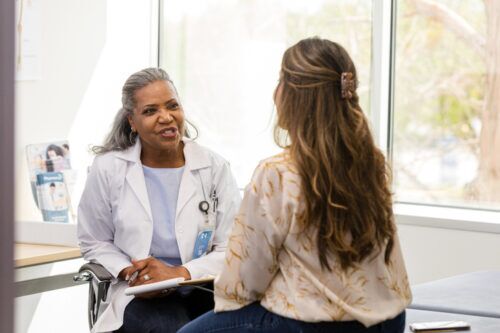Breast Cancer Risk Assessment Explained

BCRF explores how breast cancer risk is measured—and highlights how the Foundation is supporting research on risk
Because of research, every year we’re learning more about breast cancer risk and risk factors—knowledge that helps us improve and personalize detection and screening, reduce diagnoses, and, one day, prevent the disease entirely.
In breast cancer research and care, calculating breast cancer risk is done in several ways. Investigators examine risk at the population level to measure the average woman’s breast cancer risk, and they compare different, smaller groups of people to see how certain factors and behaviors influence risk. Doctors use risk models and studies to help patients make informed choices about screening, navigate high-risk gene mutations, take steps to reduce their individual risk, and more.
Read on to learn how researchers calculating breast cancer risk, how risk changes with age, and how BCRF advances risk-related research.
Ways of calculating breast cancer risk
To talk about breast cancer risk, we need to zoom out and talk about risk more generally. Risk refers to the likelihood that something, such as a breast cancer diagnosis, will happen. Scientists and clinicians measure risk in two primary ways: absolute risk and relative risk.
Absolute risk (also called cumulative risk) is a term used to describe the chance that something will happen—such as a breast cancer diagnosis—over a set time. If you’ve heard the commonly cited estimate that one in eight women will be diagnosed with breast cancer in her lifetime, then you’ve encountered a measure of absolute risk. This calculation comes from estimates showing that the average 35-year-old woman in the U.S. who doesn’t have any known breast cancer risk factors, has a 12.9 percent (roughly one in eight) chance of developing invasive breast cancer by age 90.
Absolute risk can be calculated over any amount of time: a year, five years, 10 years, and so on. When absolute risk is estimated for the course of someone’s life, such as in the estimation above, that’s called lifetime risk.
This form of risk calculation is helpful for looking at large, population-wide trends, but it doesn’t account for any one person’s unique risk of breast cancer. In other words: Your individual breast cancer risk could be higher or lower than 12.9 percent given your genes (including whether you carry a breast-cancer associated gene mutation such as BCRA1/2), ancestry, family history, lifestyle, and many other factors.
Relative risk is used to compare risk between groups. When researchers and doctors talk about specific risk factors for breast cancer, they are referring to relative risk. This measure is helpful for considering how things like lifestyle choices play a role in a person’s overall breast cancer risk, but this measure can also be confusing—particularly in news headlines without important context.
In breast cancer, for example, researchers have looked at alcohol use as a risk factor for breast cancer. Heavy drinkers—women who have three or more drinks per day or eight-plus drinks per week—have been found to have a 61 percent higher risk of breast cancer compared to non-drinkers. This doesn’t mean that 61 percent of heavy drinkers will be diagnosed with breast cancer sometime in their lifetimes. It means that their breast cancer risk is 61 percent higher than a non-drinker’s risk.
In a breast cancer clinical trial, a researcher might also calculate relative risk of a breast cancer recurrence based on how one group in the trial responded to treatment compared with how another group responded.
Relative risk is a useful measure, but it’s important to remember it can easily sound alarmingly high on first glance. Remember that relative risk compares two things and is one part of a larger picture of risk.
Risk of breast cancer by age
The 12.9 percent average absolute risk of breast cancer for women born in the U.S. that’s discussed above is a good starting point. But breast cancer risk is not fixed over the course of a woman’s lifetime, because breast cancer risk increases with age.
According to current Surveillance, Epidemiology, and End Results (SEER) Program estimates from the National Cancer Institute, a woman in the U.S. at these ages has the following risk of developing breast cancer over the next 10 years:
- Age 30: 0.49 percent (or 1 in 204)
- Age 40: 1.55 percent (or 1 in 65)
- Age 50: 2.40 percent (or 1 in 42)
- Age 60: 3.54 percent (or 1 in 28)
- Age 70: 4.09 percent (or 1 in 24)
Again, these numbers are overall averages for all U.S. women and don’t reflect someone’s individual risk of breast cancer, but they do show how breast cancer risk by age changes.
Assessing your lifetime risk of breast cancer
Healthcare providers often use the National Cancer Institute’s Breast Cancer Risk Assessment tool (also known as the Gail model or Gail risk assessment) to estimate someone’s average five-year and lifetime risk of breast cancer. The breast cancer risk assessment method has limits; it cannot predict anyone’s individual risk or give good risk estimates for women with inherited gene mutations or histories of lobular and ductal carcinomas in situ. But it can help inform screening and risk-reduction strategy recommendations.
In 2013, longtime BCRF investigator and breast cancer prevention expert Dr. Graham Colditz developed the Rosner-Colditz model for breast cancer risk with BCRF support. This breast cancer risk assessment was notable for not only considering well-established factors known to increase a person’s risk of the disease (such as alcohol consumption, age of first menstrual cycle, and weight) but also those factors that were not included in other models (such as what age a woman started menopause). A subsequent validation study found that Dr. Colditz’ model outperformed the NCI model.
Unlike NCI’s Gail model—which should only be used by providers—Washington University School of Medicine’s Siteman Cancer Center provides a patient-friendly version of the Rosner-Colditz model via its Your Disease Risk website.
Another breast cancer risk assessment tool clinicians commonly use is the Tyrer-Cuzick model, developed by BCRF investigator Dr. Jack Cuzick, which looks at family history in-depth. A patient-friendly version can be found here.
While these breast cancer risk assessment tools cannot and should not replace discussions with your doctor, they may be a useful starting point to assess your habits, see how they influence your breast cancer risk, and guide further conversations with your healthcare team.
BCRF’s research into breast cancer risk
To drastically reduce breast cancer incidence rates and death, BCRF’s overall research portfolio includes a significant investment in breast cancer prevention research and all it encompasses—personalized breast cancer risk assessment, early detection, individual risk-reducing lifestyle interventions, and everything in between.
The Foundation is currently funding numerous projects to advance our understanding of risk factors for breast cancer. These projects include studies to:
- Understand obesity, weight loss, and exercise and their impacts on breast cancer risk and outcomes
- Improve and personalize breast cancer screening and risk prediction models
- Test risk-reducing diet, exercise, weight loss, and other lifestyle programs
- Investigate early-life behaviors
- Examine the links between the gut microbiome, diet, and breast cancer risk
These investments work in concert with the Foundation’s significant support of research into uncontrollable risk factors for breast cancer—including genetics, ethnicity and race, environmental exposures, family history—and ways to apply principles of precision medicine to prevention strategies via our pioneering Precision Prevention Initiative.
BCRF investigators are at work on every angle of breast cancer prevention and risk reduction research to ultimately stop the disease in its tracks.
Selected References 
Alcohol and Cancer Risk Fact Sheet. (2021, July 14). National Cancer Institute. https://www.cancer.gov/about-cancer/causes-prevention/risk/alcohol/alcohol-fact-sheet
Breast Cancer Risk in American Women. (2020, December 16). National Cancer Institute. https://www.cancer.gov/types/breast/risk-fact-sheet
Cancer of the Breast (Female) – Cancer Stat Facts. (n.d.). SEER. https://seer.cancer.gov/statfacts/html/breast.html
LoConte, N. K., Brewster, A. M., Kaur, J. S., Merrill, J. K., & Alberg, A. J. (2018). Alcohol and Cancer: A Statement of the American Society of Clinical Oncology. Journal of Clinical Oncology, 36(1), 83–93. https://doi.org/10.1200/jco.2017.76.1155
Strait, J. E. (2016, January 13). Better predictor of breast cancer risk developed – The Source – Washington University in St. Louis [Press release]. https://source.wustl.edu/2013/11/better-predictor-of-breast-cancer-risk…









